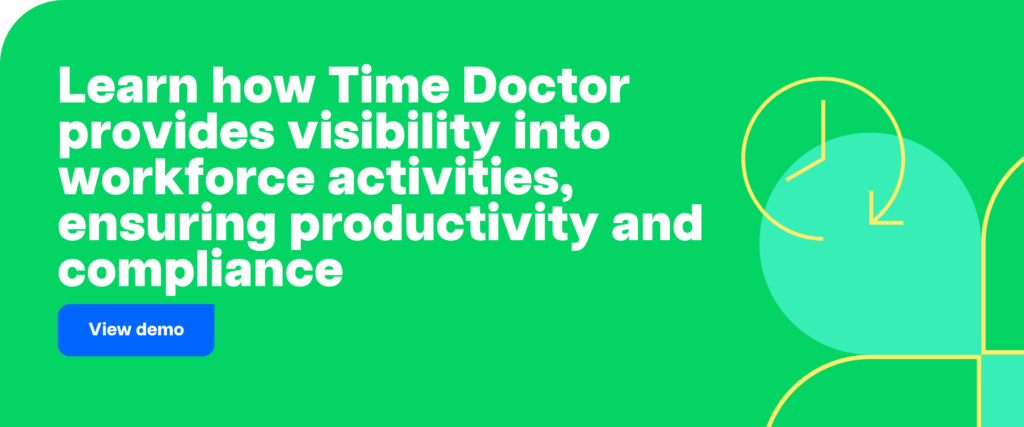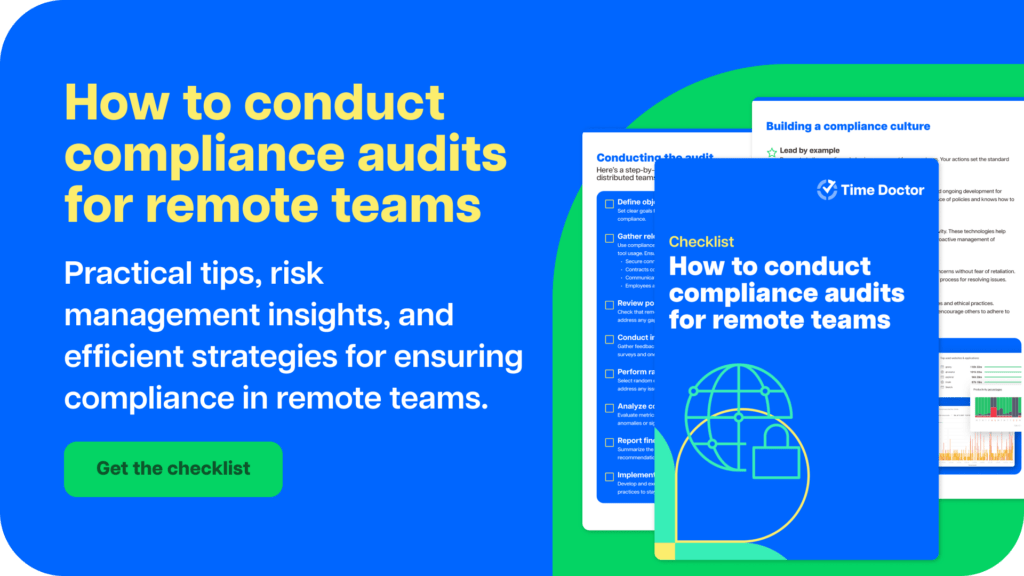Information security is one of the most talked-about topics nowadays.
And for good reason.
According to IBM, the average cost of a data breach in 2024 was a record-high $4.88 million, a 10% increase over the previous year. Breaches affecting data hosted in public clouds had the highest average cost at $5.17 million.
With more business functions being outsourced, more people working remotely, and more data stored and processed in the cloud, there’s no room for lax security.
One savvy group of CPAs (Certified Public Accountant) is tackling this increasingly complex challenge with a new approach to compliance for service organizations.
Here’s everything you need to know about SOC 2 compliance, including how to design and demonstrate effective controls.

Table of Contents
- What is SOC 2 compliance?
- Non-compliance risks
- SOC 2 compliance checklist
- How Time Doctor protects your data
What is SOC 2 compliance?
SOC 2, or Service Organization Control 2, is a voluntary compliance standard developed by the American Institute of CPAs (AICPA) to help service organizations manage customer data.
SOC 2 audits and SOC 2 reports assess an organization’s controls across five “trust services criteria”:
1. Security
Protecting systems and information from unauthorized access, disclosure, use, modification, disruption or destruction.
2. Availability
Systems and information must be usable when needed and as committed.
3. Processing integrity
Ensuring system processing is complete, accurate, timely and authorized.
4. Confidentiality
Protecting sensitive information from unauthorized access.
5. Privacy
How the system collects, uses, retains, discloses and disposes of personal information.
All SOC 2 compliance audits look at security. The other four criteria are optional.
We’ll explain that in more detail later, or you can skip ahead to understand the compliance standards.
What kind of organizations should have a SOC 2 report?
SOC 2 has become the de facto compliance standard for North American companies. It’s often compared to ISO 27001, the globally recognized compliance framework.
There are similarities. SOC 2 focuses more on an organization’s controls, while ISO 27001 is a comprehensive and general approach to information security.
While SOC 2 compliance is voluntary, it’s highly recommended for any organization that handles sensitive customer data:
- SaaS companies: Software-as-a-service providers that store customer data in the cloud.
- Cloud service providers: Any company offering cloud-based services, including data storage and transfer.
- Financial institutions: Banks, credit unions, and other financial service providers.
- BPOs: Call centers, IT support, data collectors and other outsourced service providers.
- KPOs: Research firms, lawyers, data analytics companies and other specialist service providers handle even more client data than BPOs.
- Healthcare organizations: Hospitals, clinics and other providers.
- Technology companies: Any company that handles sensitive customer data.
- eCommerce platforms: Online marketplaces and payment providers processing customer data and financial transactions.
Integrating SOC 2 into your compliance strategy not only helps to protect sensitive data but also enhances brand credibility and provides assurance for clients and partners.
It demonstrates a commitment to data security and privacy, which can be a significant competitive advantage.
Additionally, many clients – particularly in regulated industries – may require service providers to be SOC 2 compliant.
In short, if your business relies on customer trust and handles sensitive information, a SOC 2 audit might be a good investment.
Which report is right for your organization?
There are two types of SOC 2 reports. As the name suggests, there is also a SOC 1 and SOC 3.
Here’s a quick guide so you don’t accidentally request the wrong report.
- SOC 1 focuses on the financial controls of a service organization. It’s relevant for organizations that process transactions on behalf of customers, such as payroll or payment processors.
- SOC 2 focuses on a service organization’s non-financial controls. SOC 2 Type 1 is a point-in-time report that evaluates how the controls are designed, while Type 2 assesses both the design and operating effectiveness over (typically) 3-12 months.
- SOC 3 is similar to SOC 2 but designed for a general audience. It provides a high-level overview of a company’s controls without the detailed information in SOC 2 reports.
Most organizations go straight for a SOC 2 Type 2 report.
Type 1 reports can be a good short-term solution if you need to close a deal quickly. However, most organizations that need to prove SOC 2 compliance will eventually need to invest in a Type 2 report.
How to achieve SOC 2 compliance
SOC 2 isn’t a certification standard. It’s not legislated, unlike data privacy and security regulations like CCPA and HIPAA.
Instead, you’ll undergo an audit to assess how effective your controls are.
However, because SOC 2 compliance reports are voluntary, they’re also not restricted by region or industry.
Firms from anywhere, in any sector, can apply for a compliance audit. The only caveat is that the auditor must be a licensed, independent CPA accredited by the AICPA.
Another key difference is that SOC 2 compliance is not a universal standard. Controls are unique to every organization.
Achieving SOC 2 compliance involves several key steps:
- Identify relevant trust service principles: Determine which of the four principles apply to your organization (security is non-negotiable).
- Document internal controls: Create detailed documentation of your controls.
- Risk assessment: Identify potential threats and vulnerabilities.
- Select a CPA firm: Choose a qualified auditor for the SOC 2 examination.
- Undergo the audit: Provide necessary documentation and evidence to the auditor.
- Remediate findings: Address any issues identified by the auditor.
- Obtain SOC 2 report: Receive the final SOC 2 report.
You will always receive a report, even if your organization doesn’t pass the audit. There are four possible results:
- Unqualified: Pass.
- Adverse: Fail.
- Qualified: Pass, but some areas need attention.
- Disclaimer of Opinion: The auditor can’t make a fair conclusion.
SOC 2 audits can be a significant investment. It’s a good idea to get professional advice to make sure your organization is prepared.
Non-compliance risks
SOC 2 might be a voluntary standard but that doesn’t mean there are no consequences for non-compliance.
We’ve split the non-compliance risks into two categories. Direct consequences are what you risk by not pursuing an audit, while indirect consequences are what you risk when you don’t put controls in place.
Direct consequences
- Competitive disadvantage: SOC 2 compliance is becoming a standard requirement for service organizations. Non-compliant companies will miss opportunities, especially with enterprise clients.
- Lost trust: End users increasingly scrutinize service providers’ data security and privacy practices. Failure to comply with SOC 2 can damage trust and lead to customer churn.
- Lower service standards: SOC 2 audits don’t just uncover security gaps. They also identify how to improve your organization’s controls and processes to deliver better services.
- More hurdles: Without a SOC 2 report, you’ll need to provide evidence of your organization’s security for each customer or client that requests it. Compiling this information takes time when you could have a ready-made report.
Indirect consequences
- Financial penalties: Data breaches and other security incidents resulting from poor security controls can incur hefty fines and legal costs – on top of direct losses.
- Business interruption: Security incidents disrupt operations and lead to losses. The average organization takes almost a month (24 days) to recover after a data breach.
- Reputational damage: A data breach or security incident can severely damage an organization’s reputation, making it difficult to attract customers and partners.
- Legal and regulatory issues: Failure to comply with SOC 2 standards often means falling foul of GDPR, HIPAA, CCPA or another regulatory framework, putting your organization at risk of legal action.
It’s essential to prioritize SOC 2 compliance to mitigate these risks and protect your organization’s reputation, finances and customer relationships.

SOC 2 compliance checklist
The five trust service principles provide a useful framework for assessing your organization’s SOC 2 compliance readiness. Here are some strategies that leading service businesses use.
1. Security
- Implement strong access controls: Use multi-factor authentication (MFA) and role-based access control (RBAC) to limit access to sensitive data.
- Regular security training: Invest in workforce compliance to ensure your employees recognize and prevent security threats like phishing and social engineering.
- Continuous monitoring: Deploy intrusion detection and prevention systems (IDPS) to monitor and alert for security breaches.
2. Availability
- Disaster recovery planning: Develop and maintain a robust disaster recovery plan that includes regular backups and tested recovery procedures.
- Performance monitoring: Implement tools to monitor system performance and uptime to ensure services are available as promised.
- Capacity management: Regularly assess and upgrade system capacity to handle peak loads and prevent downtime.
3. Processing Integrity
- Data validation controls: Implement input, processing, and output validation checks to ensure data integrity throughout processing.
- Error handling procedures: Establish procedures to promptly detect, log, and correct processing errors.
- Transaction monitoring: Use real-time transaction monitoring to ensure data processing is accurate and authorized.
4. Confidentiality
- Data encryption: Encrypt sensitive data at rest and in transit using strong encryption protocols.
- Data minimization: collect only the data necessary for your operations and minimize the storage of sensitive information.
- Third-party agreements: Ensure third-party vendors comply with your confidentiality policies and have adequate safeguards.
5. Privacy
- Privacy policies: Develop clear policies that outline how personal information is collected, used, and protected.
- User consent: Obtain explicit consent from users before collecting and processing their personal data.
- Data subject rights: Implement processes to manage and respond to data subject requests, such as access, correction, and deletion of personal information.
Following these best practices and tailoring them to your organization can significantly enhance your security posture and increase your chances of achieving SOC 2 compliance.
How Time Doctor protects your data

SOC 2 compliance is something we’re especially interested in here at Time Doctor because we’re currently in the process of achieving compliance.
We are already ISO 27001 certified. Working towards SOC 2 compliance (Type 2, of course) is important to demonstrate the effectiveness of our information management controls.
As the industry leader in workforce management software, data security is one of our highest priorities. The integrity of our systems directly impacts our clients’ experience.
We follow SOC 2 best practices, including:
- Encrypted data transfer (HTTPS)
- Email verification
- Strong password management policies
- Internal system logging
- Network and infrastructure security
- Physical security
- Two-factor authentication (2FA)
Moreover, Time Doctor plays an active role in achieving SOC 2 compliance.
Our workforce analytics features provide actionable insights that help you monitor unusual activities, identify potential risks and ensure compliance.
With features such as accurate time tracking, internet usage monitoring, detailed analytics and automated alerts, Time Doctor helps you maintain a secure and compliant work environment.
Our Unusual Activity Report (UAR) specifically targets potential non-compliant behaviors like employees using work-faking tools, ensuring your workforce remains aligned with SOC 2 standards.
By leveraging Time Doctor, you can not only improve productivity and transparency but also support your journey towards achieving and maintaining SOC 2 compliance.Learn more about compliance and security at Time Doctor, or start your free trial with the confidence that your data is always secure.

Liam Martin is a serial entrepreneur, co-founder of Time Doctor, Staff.com, and the Running Remote Conference, and author of the Wall Street Journal bestseller, “Running Remote.” He advocates for remote work and helps businesses optimize their remote teams.


